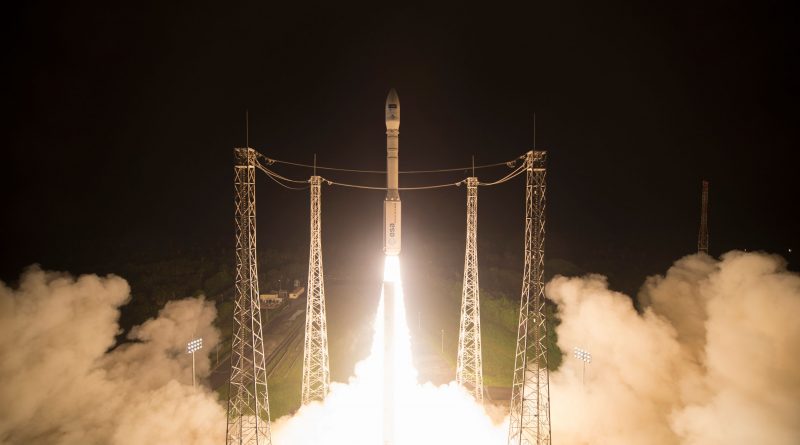Sentinel-2B enjoys smooth Orbital Delivery atop Vega Rocket to join Europe’s Copernicus Fleet
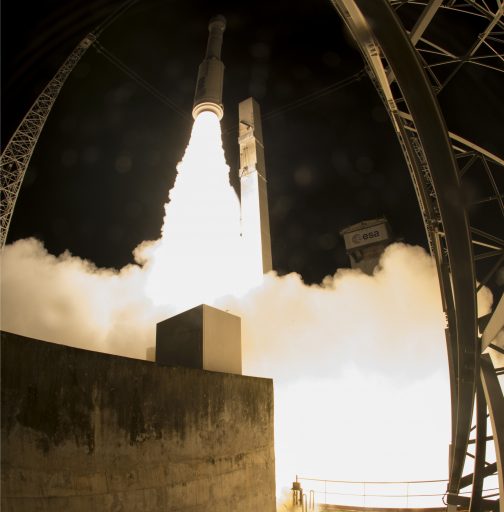
Vega – the smallest in Europe’s line of launch vehicles – lit up the night skies over the edge of the Amazon on Monday, thundering off to lift the newest member in the Copernicus constellation to orbit, taking the pulse of an ever-changing planet with a series of active observation posts circling the Earth.
The 30-meter tall Vega rocket leapt off its launch pad at the Guiana Space Center at precisely 1:49:24 UTC on Tuesday, departing South America to the north to dispatch the satellite to a Sun Synchronous Orbit where it will join its twin, launched back in 2015, and three other Sentinel satellites feeding information back to Earth for use by policy-makers, scientists, corporations and private individuals.
Vega fired its three large solid-fueled motors in close succession, accelerating on a sub-orbital arc from where the liquid-fueled AVUM upper stage was tasked with a pair of engine burns to first lift the stack into an elliptical transfer orbit prior to a critical circularization maneuver to release Sentinel-2B into an orbit close to 800 Kilometers in altitude 57 minutes after liftoff.
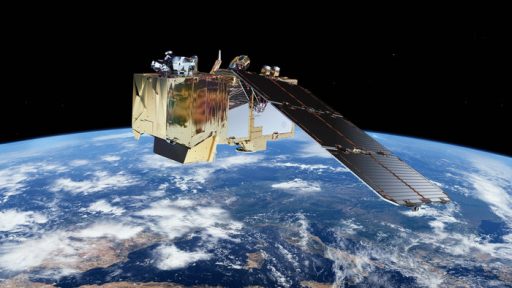
Copernicus, a €6.7-billion program headed by the European Commission in partnership with ESA, aims to deploy a satellite system capable of collecting relevant, accurate and timely Earth observation parameters for use in a variety of areas. Sentinel is the space segment of Copernicus, comprising six different types of satellites to deploy a range of sensors to orbit to capture the full spectrum of data under one program. Benefits of Copernicus include improvements in environmental monitoring, resource management, urban planning, emergency response and security.
Sentinel-2B is the fifth Sentinel satellite launched to date. Sentinel-1, currently with two satellites in orbit, represents the radar component of the constellation for all weather, round-the-clock data acquisition.
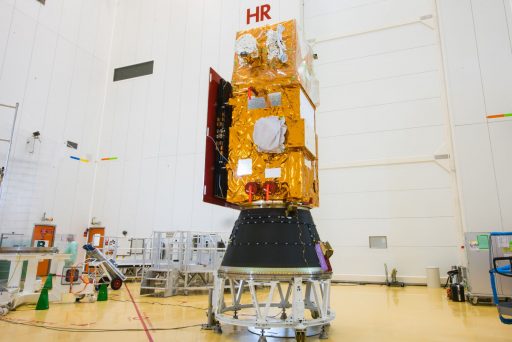
The Sentinel-2 twins deliver multispectral imagery of the entire land mass of Earth every five days to keep close watch over a changing planet. Sentinel-3, currently with one satellite in orbit, is regarded as the most comprehensive in the constellation, hosting visible, infrared and microwave detectors for data collection over land and sea.
Sentinel-4 will be a hosted payload deployed to Geostationary Orbit by a Meteosat Third Generation Craft, collecting UV-to-near-Infrared spectra for atmospheric monitoring. Sentinel-5, also a hosted payload, will fly on the MetOp Second Generation polar-orbiting satellites, collecting spectrometric data in the UV-to-IR range; A Sentinel-5 Precursor will launch later this year to patch a gap in atmospheric data after EnviSat stopped working in 2012. Finally, Sentinel-6 will be tasked with continuing a record of precise ocean altimetry data started by the Jason-2/3 missions and relevant in understanding climate change processes.
>>Sentinel-2 Technical Overview
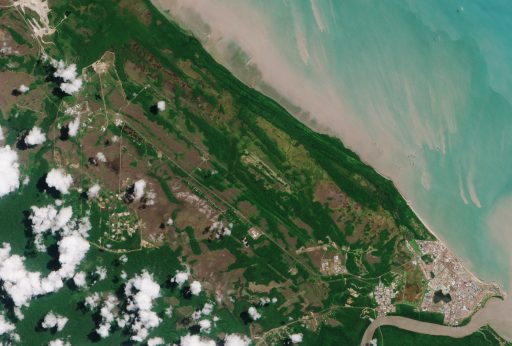
The newest member of the constellation, Sentinel-2B, will enter an orbit opposite to its twin, Sentinel-2A launched in June 2015. This orbital geometry will optimize multispectral coverage and data delivery, enabling the two satellites to cover the entire Earth’s surface in five days. Achieving a swift revisit cycle provides a close look at rapidly progressing phenomena as well as activity over long periods of time by establishing a long-duration record of Earth in various wavelengths.
The Sentinel-2 twins were built by Airbus Defence and Space based on the AstroBus-L platform, with each satellite weighing in at 1,140 Kilograms at liftoff. The principal instrument of the Sentinel-2 satellites is the MultiSpectral Imager MSI, sensitive in 13 channels from the visible into the infrared wavelength range from 0.4 to 2.4 micrometers. The 275-Kilogram instrument hosts a three-mirror optical system and two focal plane assemblies, capturing a 290-Kilometer wide ground swath and reaching a resolution between 10 and 60 meters depending on the wavelength.
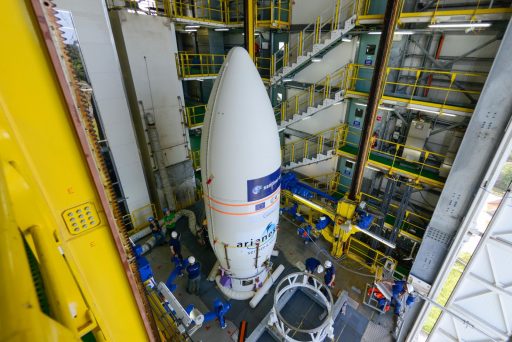
Orbiting the Earth 786 Kilometers in altitude, the Sentinel-2 twins deliver data compatible with the SPOT and Landsat Earth observation programs, enabling the collection of long-term temporal image series for an unprecedented look at Earth in terms of revisit cycle, spectral diversity and image resolution.
Circling the Earth 14.3 times per day, the Sentinel-2 twins capture data of all land masses, large islands, coastal areas and in-land water bodies between 56° South and 84° North. Sentinel-2 data finds application in land cover monitoring, agricultural applications such as crop monitoring to ensure food security, vegetation assessments, marine environmental monitoring in coastal zones, inland water quality assessments, glacier movement observation, and disaster management. All data products are made available freely through a web interface for users to process and distribute.
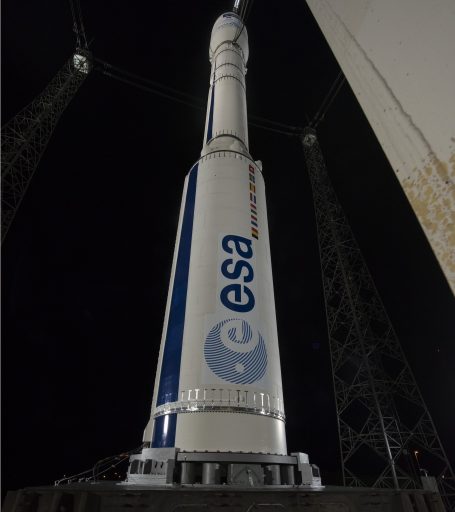
Sentinel-2B’s ride to space was Vega, heading off on its ninth mission assignment, the sixth to a Sun Synchronous Orbit favored by Earth-imaging missions. Vega, a four-stage rocket, premiered in 2012 as the smallest in Arianespace’s line of launchers optimized for the delivery of small Earth-observation and scientific satellites into a variety of orbits, also supporting multi-orbit missions and up to six microsatellites secondary payloads per mission.
Vega entered a lengthy countdown nine hours prior to the day’s instantaneous launch opportunity, progressing through systems activation, detailed checkouts and flight software load while the satellite – controlled from the European Space Operations Center in Germany – went through its final preparatory steps. Tracking stations on four continents confirmed readiness for flight and weather forecasters reported favorable weather and upper level wind conditions as Vega was revealed on its ZLV launch pad when, three hours before launch, the protective Service Gantry was moved to its launch position.
A repetition of checkouts inside L-2 hours set the stage for a last set of reconfigurations to have Vega ready for automated countdown with plenty of time to spare. Sentinel-2B made its switch to battery power and all stations gave final approval to press into the Synchronized Sequence picking up at T-4 minutes. As part of the highly choreographed activity, Vega was transitioned to internal power, assumed control of the countdown and a last automated check showed all was in readiness for ignition.
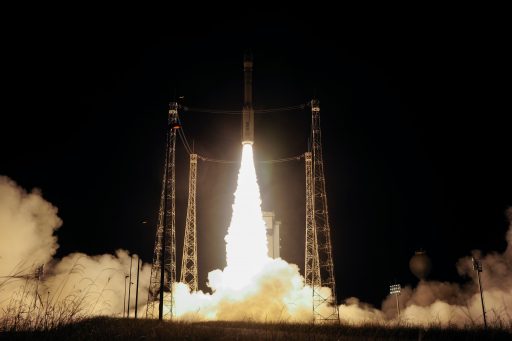
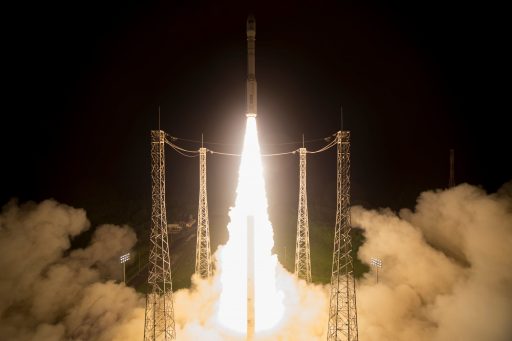
As clocks hit zero and the massive P80 solid rocket motor ignited, Vega catapulted off the ground and toward the dark sky over the Guiana Space Center, climbing vertically with a thrust peaking at 300 metric ton force. The rocket quickly turned to the north to head toward a polar orbit.
Burning 820 Kilograms of propellant per second, the P80 accelerated Vega beyond the speed of sound just half a minute after liftoff, followed by the area of Maximum Pressure a short time later. Thrust on the 11.2-meter long first stage tailed off one minute and 45 seconds into the flight, having boosted Vega to a speed of 1.8 Kilometers per second.
First stage burnout was sensed by the declining pressure within the filament-wound casing, triggering the flight computers to command the separation of the spent stage at T+1:55. The second stage, called Zefiro 23, fired up immediately after staging, delivering 122 metric ton-force of thrust to raise the rocket’s speed to nearly 4 km/s via a 77-second burn. Stage 2 burned out after consuming 24 metric tons of packed propellant and the vehicle coasted uphill for half a minute before the 8.4-meter stage dropped away three minutes and 39 seconds into the mission.
Twelve seconds after stage separation, the Zefiro-9 third stage ignited on a burn of nearly two minutes with a peak thrust of 32 metric tons, raising Vega’s speed to almost match orbital velocity. Five seconds into third stage operation, Vega split open and dropped its two payload fairing halves as the vehicle had reached 130 Kilometers in altitude where aerodynamic forces were no longer a concern to Sentinel’s delicate structure.
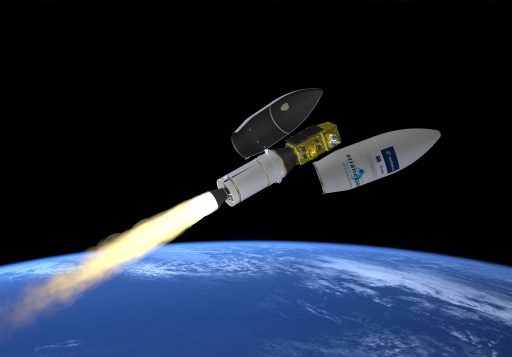
Burning through ten metric tons of propellant, the third stage tailed off just shy of T+6 minutes reaching a top speed of 7.61 Kilometers per second. Vega held the 4.1-meter long Zefiro-9 until T+6:36 when cutting charges fired and springs pushed the AVUM upper stage away from the booster.
Now in charge of powered flight, the AVUM – Attitude and Vernier Upper Module – stabilized its orientation and coasted for two minutes before firing up its Ukrainian-built, RD-869-derived main engine to boost the vehicle into orbit.
AVUM, loaded with 577 Kilograms of propellant, can support extended missions with up to five re-starts of its engine to deliver payloads into a variety of orbits at high injection accuracy. Sentinel’s high-speed delivery required the stage to make two burns, plus a de-orbit maneuver after satellite separation.
Generating 250 Kilogram-force of thrust, AVUM’s first task was lifting Sentinel-2B into an elliptical parking orbit by firing its engine for just over seven minutes. The upper stage was also programmed to dynamically adjust its flight profile in order to correct any errors occurring on the lower stages.
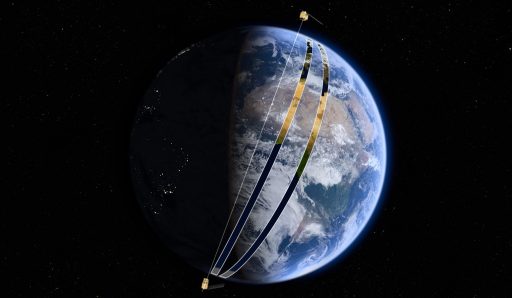
Traveling to the high point of its 700+-Kilometer parking orbit, AVUM coasted for 40 minutes before firing up its Main Engine Assembly at T+55 minutes for a burn of exactly two minutes to raise the perigee and lift Sentinel-2 into a circular orbit.
Vega was aiming for an injection orbit 11 Kilometers below that of Sentinel-2A – a built-in safety feature to ensure the satellite’s operational orbit remains clean even in the event of a botched launch or Sentinel-2B failure shortly after launch which could leave the mission’s operational orbit littered with debris. As part of in-orbit checkouts, Sentinel-2B will complete maneuvers to enter the operational orbit at the correct phasing to its twin.
Separation of Sentinel-2B was confirmed 57 minutes after liftoff, drifting away from the AVUM upper stage after receiving a smooth ride into orbit.
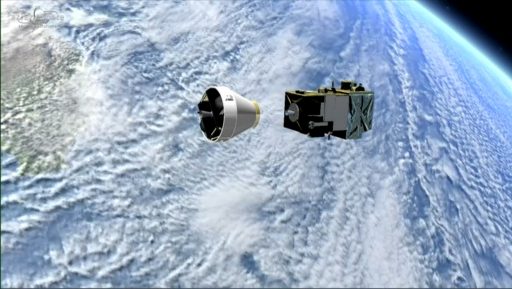
Sentinel-2B checked in with ground stations shortly after separation, confirming it was in good shape and in the correct orbit, ready for three days of fast-paced operations as part of its Launch and Early Orbit Phase to set up for a multi-month commission and calibration campaign before Sentinel-2B will be hooked up to the Copernicus data pipeline for a seven-year operational life.
Monday night’s launch was the third mission operated by Arianespace in 2017, coming after January’s Soyuz launch to Geostationary Transfer Orbit with Hispasat 36W-1 and a dual-payload launch by Ariane 5 in February. The company’s next mission will again see Ariane 5 lift a pair of communications satellites, currently targeting liftoff on March 21 with SGDC-1 and KoreaSat-7. In total, Arianespace is aiming for an even dozen launches this year, seven with Ariane 5, three with Vega and two with Soyuz.

